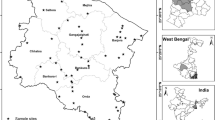Abstract
Bayesian frameworks for comparing water quality information to a pre-specified standard or goal and comparing water quality characteristics among two different entities are presented and illustrated using chloride and total dissolved solids (TDS) measurements obtained in the shallower Chicot and the deeper Evangeline formations of the Gulf coast aquifer underlying Refugio County, TX. The Bayesian approach seeks to present evidence in favor of the competing hypotheses which are weighed equally and unlike classical statistics do not make a decision in favor of one hypothesis. When comparing water quality information to a specified goal, the Bayesian approach addresses the more practical question—given all the information, what is the probability of meeting the goal? Similarly, when comparing the water quality between two entities, the approach simply emphasizes the nature and extent of differences and as such is better suited for evaluative studies. Bayesian analysis indicated that average chloride concentrations in the Evangeline formation was 1.65 times the concentrations in the Chicot formation while the corresponding TDS concentration ratio was close to unity. The probability of identifying water with TDS ≤1,000 g/m3 was extremely low, especially in the more prolific Evangeline formation. The probability of groundwater supplies with mean chloride concentrations ≤500 g/m3 was relatively high in the Chicot formation but very low in the Evangeline formation indicating the possible need for blending groundwater with other sources to meet municipal water quality goals.





Similar content being viewed by others
References
American Public Health Association (APHA) (1995) Standard methods for the examination of water and wastewater. American Public Health Association, Washington
Bonham-Carter GF, Agterberg FP, Wright DF (1989) Weights of evidence modeling: a new approach to mapping mineral potential. Stat Appl Earth Sci 89(9):171–183
Borsuk ME, Stow CA (2000) Bayesian parameter estimation in a mixed-order model for BOD decay. Water Res 34:1830–1836
Borsuk ME, Higdon D, Stow CA, Reckhow KH (2001) A Bayesian hierarchical model to predict benthic oxygen demand from organic matter loading in estuaries and coastal zones. Ecol Modell 143:165–181
Chowdhury AH, Wade S, Mace RE, Ridgeway C (2004) Groundwater availability model of the central gulf coast aquifer system: numerical simulations through 1999. Texas Water Development Board, Austin, p 108
Dilks DW, Canale RP, Meier PG (1992) Development of a Bayesian Monte Carlo techniques for water quality modeling under uncertainty. Ecol Modell 62:149–162
Hamilton LC (1993) Regression with graphics—a second course in applied statistics. Brooks/Cole Publishing Company, Pacific Grove
Hobbs BF (1997) Bayesian methods for analyzing climate change and water resources uncertainties. J Environ Manage 49: 53–72
Koop G (2003) Bayesian econometrics. Wiley, Hoboken
Lee S, Choi J, Min K (2002) Land slide susceptibility analysis and verification using the Bayesian probability model. Environ Geol 43: 120–131
Mason C (1963) Water resources of Refugio County, TX. Texas Water Commission, Austin
Moorthy SR (2005) Hydrologic field investigations in Refugio County, TX. MS Thesis.Texas A&M University-Kingsville, Kingsville
Ouali A, Cherif AR, Krebs M-D (2006) Data mining based Bayesian networks for best classification. Comput Stat Data Anal (in press)
Qian SS, Stow CA, Borsuk ME (2003) On Monte Carlo methods for Bayesian inference. Ecol Modell 159: 269–277
Roiger RJ, Geatz MW (2003) Data Mining—a tutorial based primer. Addison-Wesley Publishing Company, Boston
Schmidtt SA (1969) Measuring uncertainty—an elementary introduction to Bayesian statistics. Addison Wesley Publishing Company, Boston
Sivia DS (2003) Data analysis—a Bayesian tutorial. Clarendon Press, Oxford
Termansen M, McClean CJ, Preston CD (2006) The use of genetic algorithms and Bayesian classification to model species distributions. Ecol Modell (in press)
USEPA (2002) Guidance on choosing a sampling design for environmental data collection; EPA/240/R–02/005. Washington
U.S. Enivronmental Protection Agency (USEPA) (2006) List of drinking water contaminants and MCLs http://www.epa.gov/safewater/mcl.html; (accessed on Feb 2006)
Winkler RL (1972) Introduction to Bayesian inference and decision. Holt, Reinhart and Winston Inc., New York
Acknowledgments
The financial support from Refugio Groundwater Conservation District for field data collection is greatly appreciated. The logistic support provided by Mr. Garrett Engelking, General Manager, Refugio Groundwater Conservation District and sampling activities carried out by Mr. Sravan Moorthy are acknowledged.
Author information
Authors and Affiliations
Corresponding author
Rights and permissions
About this article
Cite this article
Uddameri, V. Bayesian analysis of groundwater quality in a semi-arid coastal county of south Texas. Environ Geol 51, 941–951 (2007). https://doi.org/10.1007/s00254-006-0457-0
Received:
Accepted:
Published:
Issue Date:
DOI: https://doi.org/10.1007/s00254-006-0457-0




